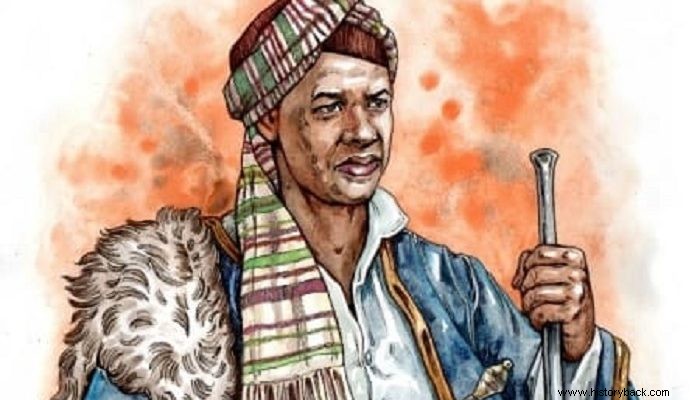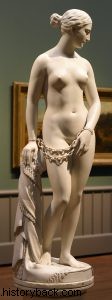
The Greek fever experienced by the USA in the 1820s and the contribution of American Philhellenism to the Greek Revolution have already been highlighted. What is less known is that the struggle of the Greeks was also supported by the African American community and that an African American fought bravely on the side of the Greeks. It is also not known that the Greek Revolution formed the basis and Greek slaves provided the symbols to promote the struggle to abolish slavery in the USA.
James Jakob Williams, was an African-American Philhellenic from Baltimore, Maryland, United States of America. He served as a Marine in the US Navy. In this capacity he participated in the war between the USA and Algeria that took place in 1815. He fought bravely and distinguished himself in these operations. In Algeria he served under the command of American Admiral Stephen Decatur, who had recognized his worth and bravery. With the end of operations in Algeria, and after completing his term in the American fleet, Admiral Decatur suggested that he go to Greece, where slavery had been abolished.
Williams arrived in Greece in January 1827 and was appointed aide to the British Philhellenic Admiral Thomas Cochrane. Williams followed Cochrane everywhere in all military operations, until the latter's withdrawal from Greece in December 1827. Williams remained in Greece and took part in various battles and naval engagements. In fact, on many occasions he had secretly infiltrated the ranks of the enemy to collect and convey valuable information to the Greeks, risking his life.
During the operations for the liberation of Nafpaktos, Williams was seriously injured by a cannon fragment in the arm and leg and was taken to the hospital in Poros. At a critical moment of the conflicts, he led a group of Greek fighters and took control of the Greek ship Sotir, which was ungovernable. In fact, he took charge of the lagudera himself, concentrating the enemy fire on him. With this act he saved the ship from capture.
This brave African-American Philhellenic, offered his life in the struggle of the Greeks. He died in 1829 in Greece. The Society for Hellenism and Philhellenism (EEF) honored James Jakob Williams who lived the last years of his life as a free man in a free Greece. But let's see what the prevailing climate was in America, especially in African-American circles at that time.
The impact of the Greek Revolution can be seen from the articles published by the first free African-American newspaper in the USA, Freedom's Journal, which was published in New York from March 1827. This newspaper, whose main interest was the struggle against slavery, saw in the Greek Revolution a struggle of slaves against tyrants. He gave news from Greece the same weight as news from Haiti, Africa and the West Indies. Among other things, Freedom's Journal published with great satisfaction on December 21, 1827 the news about the Battle of Navarino.
It is interesting that this newspaper also viewed with sympathy the janissaries, whom it (not unreasonably) considered slaves massacred by the "tyrant" Mahmut II (in 1826), as well as the women of the harems, which it also considered slaves. In fact, this newspaper also published Philhellenic poems. Like "Greek Song" and "To Greece" and "Song of the Janissary". These poems repeat the slogan "freedom or death" and project the image of chains, the typical symbol of slavery. Here are some lyrics in free rendering:
IN GREECE (F.J. 12/10/1827)
Rejoice, land of Leonidas, [...]
Do not be cowardly, descendants of the heroes of Marathon.
Better to fall where your ancestors rest,
than to drag the terrible Ottoman chains. [...]
HELLINIKO ASMA (F.J. 7 Sep. 1827)
Soldier, saddle the brave horse.
Run, run into the fire of war.
It is better there to bleed and die,
Than to drag the tyrant's chariot. […]
Hit! Strike! Do not think that the blow that breaks the chains is wasted. […]
There, where Karaiskakis points!
Where the crescent waves, […]
THE SONG OF THE JENIZAR (F.J., 4/5/1827)
For a while only, the tyrant will win,
but he and his followers will fall before us.
The fate that rolled Selim from the throne in blood,
will also yours, weary Mahmut, we swear. [...]
Watch out, cruel Mahmut! Your time has come […].
News clippings from the Philhellenic activities of various "Hellenic Committees" in the USA. Above:a twelve-year-old boy donates his watch to the Philhellenic Committee of Pittsburgh, with the request that the proceeds be given to starving Greeks (Freedom's Journal). The sad fate of the hundreds of thousands of Greek slaves sold daily in the Mediterranean slave markets shocked American society during the first half of the 19th century. American Philhellenic volunteers who experienced this horror (Dr. Samuel Gridley Howe, Jonathan Pecham Miller, etc.), became leading figures in the struggle against African American slavery in the US. This fight had a central symbol. The Greek slave.
The Greek Slave was the famous sculpture created by the great American sculptor Hiram Powers in 1844. It is the story of a little girl from Psara. Garifalia Mohalvi (1817 – 1830), comes from Psara. Her parents were massacred during the massacre of Chios and little Garifalia was sold by the Turks as a slave. Completely by chance, it was discovered by the American Consul Joseph Langston in Smyrna. After many attempts he managed to free her and sent her in 1827 to Boston.
The history of Garifalia and its beauty inspired the sculptor Hiram Powers to create in 1844 one of the masterpieces of world sculpture of the 19th century, entitled "Greek Slave". Today the original statue is in the Brooklyn Museum. A copy of it is in the Museum of Philhellenism in Athens (www.phmus.org). This statue of the Greek slave was the central emblem of the struggle and campaigns for the abolition of slavery in the USA.

SOURCE:eefshp
